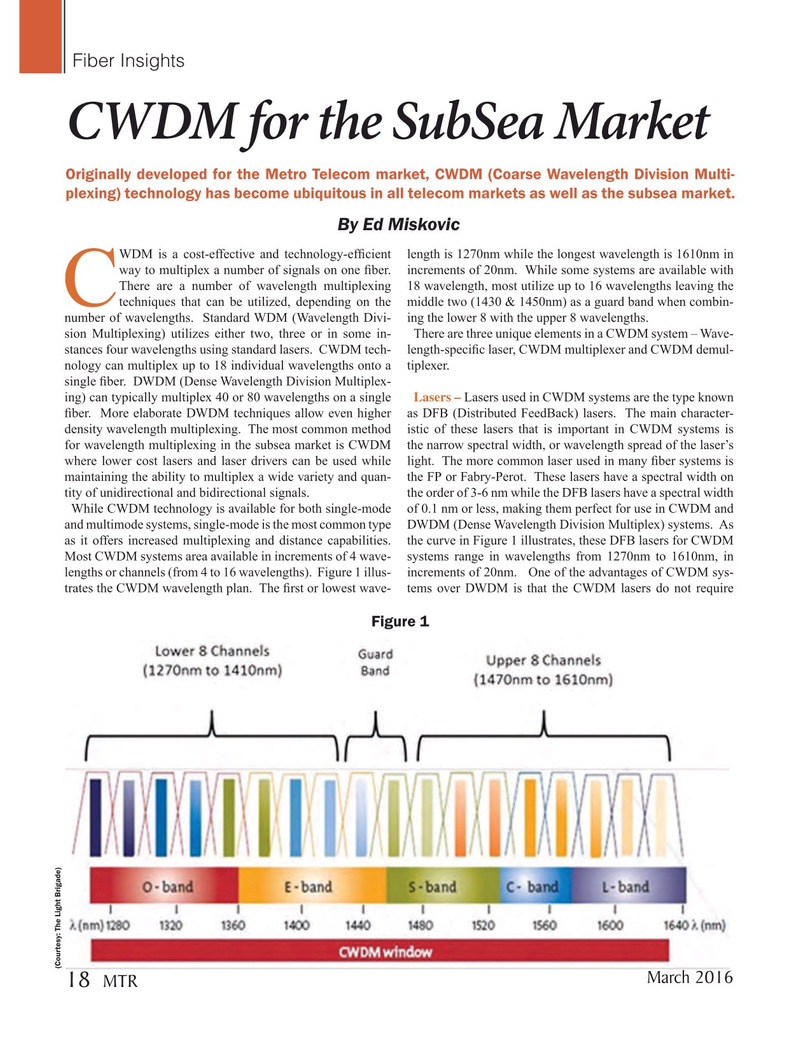
Page 18: of Marine Technology Magazine (March 2016)
Oceanographic Instrumentation: Measurement, Process & Analysis
Read this page in Pdf, Flash or Html5 edition of March 2016 Marine Technology Magazine
Fiber Insights
CWDM for the SubSea Market
Originally developed for the Metro Telecom market, CWDM (Coarse Wavelength Division Multi- plexing) technology has become ubiquitous in all telecom markets as well as the subsea market.
By Ed Miskovic
WDM is a cost-effective and technology-ef? cient length is 1270nm while the longest wavelength is 1610nm in way to multiplex a number of signals on one ? ber. increments of 20nm. While some systems are available with
There are a number of wavelength multiplexing 18 wavelength, most utilize up to 16 wavelengths leaving the
Ctechniques that can be utilized, depending on the middle two (1430 & 1450nm) as a guard band when combin- number of wavelengths. Standard WDM (Wavelength Divi- ing the lower 8 with the upper 8 wavelengths.
sion Multiplexing) utilizes either two, three or in some in- There are three unique elements in a CWDM system – Wave- stances four wavelengths using standard lasers. CWDM tech- length-speci? c laser, CWDM multiplexer and CWDM demul- nology can multiplex up to 18 individual wavelengths onto a tiplexer. single ? ber. DWDM (Dense Wavelength Division Multiplex- ing) can typically multiplex 40 or 80 wavelengths on a single Lasers – Lasers used in CWDM systems are the type known ? ber. More elaborate DWDM techniques allow even higher as DFB (Distributed FeedBack) lasers. The main character- density wavelength multiplexing. The most common method istic of these lasers that is important in CWDM systems is for wavelength multiplexing in the subsea market is CWDM the narrow spectral width, or wavelength spread of the laser’s where lower cost lasers and laser drivers can be used while light. The more common laser used in many ? ber systems is maintaining the ability to multiplex a wide variety and quan- the FP or Fabry-Perot. These lasers have a spectral width on tity of unidirectional and bidirectional signals. the order of 3-6 nm while the DFB lasers have a spectral width
While CWDM technology is available for both single-mode of 0.1 nm or less, making them perfect for use in CWDM and and multimode systems, single-mode is the most common type DWDM (Dense Wavelength Division Multiplex) systems. As as it offers increased multiplexing and distance capabilities. the curve in Figure 1 illustrates, these DFB lasers for CWDM
Most CWDM systems area available in increments of 4 wave- systems range in wavelengths from 1270nm to 1610nm, in lengths or channels (from 4 to 16 wavelengths). Figure 1 illus- increments of 20nm. One of the advantages of CWDM sys- trates the CWDM wavelength plan. The ? rst or lowest wave- tems over DWDM is that the CWDM lasers do not require
Figure 1 (Courtesy: The Light Brigade)
March 2016
MTR 18
MTR #2 (18-33).indd 18 2/19/2016 10:57:42 AM

 17
17

 19
19
